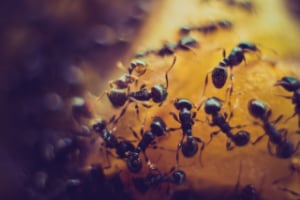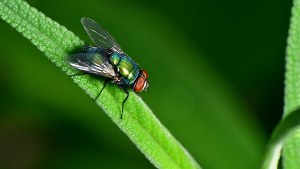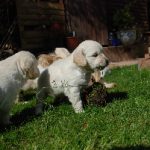
I remember when my youngest Golden, Sylvie, as a puppy would stare intently at ants as they crawled across the patio in the summer.
Her nose would almost be touching them as she was transfixed.
Now as an adult she has graduated to staring intently at squirrels and pigeons- they don’t strain the eyes as much.
But what do you do if you have a dog (a puppy most likely) who not only stares at ants but feasts on them? And then throws up?
Are ants poisonous to dogs? Stay with me as we find out.
What you will learn from this article:
- What types of ants are most common (in the USA)
- Two main reasons that dogs eat ants
- Six ways to get ants off a dog
- How do ants find food?
- Why are ants attracted to dog food?
- How to keep ants away from dog food?
- My dog ate ants and threw up (four considerations)
What types of ants are most common (in the USA)
Worldwide there thought to be twenty thousand different species of ants. In the US there are about seven hundred different species and about twenty five different species that we see in and around our homes.
Some of the most common species include:
| Name | Sting | Bite | Disease | Diet | |
| (1) | Argentine | No | Yes | Not to dogs | Meats, sugars |
| (2) | Carpenter | No | Yes | No | Meats, sugars |
(3) | Pharaoh | No | Yes | Salmonella, Streptococcus | Meat, fat, blood |
| (4) | Sugar | No | Yes | No | Anything sweet |
| (5) | Black House | No | Yes | No | Anything sweet |
| (6) | Odorous House | No | No | No | Anything sweet |
So in the chart above, I have highlighted six different species of ants that are most common in the US.
Firstly, none of these ants are known to sting, but most of them can bite. The exception is the odourless ant which doesn’t bite or sting.
In terms of the danger that any of them present to your dog, looking at the disease column, all but one of these ants are harmless and they don’t pose a threat to your dog (or yourself.)
But there are a few exceptions.
The Pharaoh ant which is known to carry diseases such as salmonella and streptococcus.
The Argentine ant is known not to carry a disease that can harm dogs or humans but it carries a disease which can kill bees.
And finally, any ant is a “wild animal” and so it will carry possible germs and diseases on their bodies.
Help! My dog ate wood and is throwing up
I will discuss the contents of the diet column in a later section.
And finally, to finish I have a question for you…
Where do Odorous ants get their names from?
It is because when they are squashed they give off an odour which smells like coconuts!
Moving quickly on, let me look next at why dogs might eat ants in the first place.
Two main reasons that dogs eat ants
I think that there is one really big reason why some dogs eat ants.
And that is because the ants are on their food or in their water bowl and so the ants are eaten accidentally, so to speak.
And I will look at ants and dog food bowls in a later section.
But, there is another reason that dogs eat ants.
Some dogs eat ants just because they can.
You could argue that dogs eat ants because they are a source of protein but I think that it is stretching the point a bit as ants are so small.
And some people will argue that dogs who eat ants have a high prey drive.
But, to me this seems to be pushing something too far.
Do dogs honestly see a small insect like an ant, as prey?!
The type of dog that will stop and munch on an ant hill whilst out on a walk or who will eat the ants that they see crawling around on the kitchen floor…
are the types of dogs who will eat any number of random things- grass or dandelions, cat poop, the list goes on.
Many puppies have this kind of “see food diet”- they will eat anything indiscriminately.
Six ways to get ants off a dog
But dogs and ants might cross paths in more ways than just in a food bowl.
A dog might accidentally disturb an ant’s nest whilst it is out on a walk.
It could be that whilst bounding after a squirrel your dog strays off the path and runs through an ants nest.
Or it could be that after a quick swim on a hot day in a river, your dog rolls on the ground on top of an ant colony.
Now the problem isn’t that your dog has eaten a few ants, it is that your dog has several crawling all over their body.
And if you have a dog that is as sensitive to anything touching their skin as my youngest is, you will have a very agitated dog on your hands.
Depending on how many ants there are on your dog, your fastest means of getting them off is to:
[1] individually pick them off your dog,
[2] brush them off with the flat of your hand.
[3] get them into a lake or river if there is one nearby
[4] look for a dried patch of dirt close by and get your dog to roll in it or for you to rub the dirt into the dog’s coat..
Now if your dog is suddenly infested with ants and you’re at home you have the luxury of two more options
[5] House the dog- using a shower attachment is better
[6] Comb or brush your dog.
How do ants find food?
Most ants find food (whether it is the splodge of grape jelly on your work surface, drops of orange juice on the floor or food in your dog’s bowl by using their keen sense of smell.
And recent research shows that they have one of the most amazing senses of smell of any animal.
The quality of its sense of smell is so good that it is sometimes labelled as “high definition”.
And the genius doesn’t end there.
Their sense of smell is not just used to find food, it is also used to find their way back home. As an ant looks for food it leaves a trail of chemical scents behind which it can later use to find its way back home or back to the food.
Carpenter ants are even more sophisticated.
Not only do they use a sense of smell to help with navigation, they use their eyes to remember landmarks on their journeys.
It sounds unbelievable but you can read about it all here!
OK. I got a bit excited, I didn’t mean to write in such detail about an ant’s sense of smell.
But in the next section, we will look at what it is about dog food that particularly attracts ants.
Why are ants attracted to dog food?
I don’t necessarily think that ants are particularly interested in dog food, it is just that it might be the one piece of “food” that is regularly left out (or the largest “lump” of food) and so is available for ants to find.
Ants have a keen sense of smell as do dogs.
Even dried dog food has been designed not only to taste nice but to smell nice as well.
And that aroma which has been designed to win over your dog, is also bound to attract ants.
Of course, canned (and wet dog food) and raw food are also highly pungent.
| Name | Sting | Bite | Disease | Diet | |
| (1) | Argentine | No | Yes | Not to dogs | Meats, sugars |
| (2) | Carpenter | No | Yes | No | Meats, sugars |
(3) | Pharaoh | No | Yes | Salmonella, Streptococcus | Meat, fat, blood |
| (4) | Sugar | No | Yes | No | Anything sweet |
| (5) | Black House | No | Yes | No | Anything sweet |
| (6) | Odorous House | No | No | No | Anything sweet |
Getting back to our ant chart, we can see that most ants have a sweet tooth but that some ants such as the carpenter or pharaoh ants will also go after meat.
How to keep ants away from dog food?
The basic thing to do is to never leave any dog food out for any ants to find.
Now this is fine for most of us who keep our dogs indoors and who feed our dogs on a strict schedule once or twice a day.
All we need to do is to remember to wash up the dog bowls after use and to throw away any “spoilt” dog food.
But what about those dog owners who keep their dogs outside or dogs that are allowed to graze and have free access to food all day long?
This is much harder to manage because it is much harder to keep clean.
Most dogs on a grazing diet will be eating kibble, which is much less of an “ant magnet” than canned or raw food.
The secret here is to keep the kibble as dry as possible because it gives of a stronger aroma when it is wet.
And the way to do this?
Hover over the bowl, removing any wet pieces of kibble 24/7!
No, I’m kidding.
The best way of keeping the kibble as dry as possible is to separate the water bowl from the food bowl, reducing the amount of water that your dog might dribble on their food!
My dog ate ants and threw up (four considerations)
Now this is an interesting case.
If your dog has eaten some ants and then vomited, it is very unlikely to be directly related to the ants.
[1] Ants aren’t in and of themselves poisonous to dogs.
Eating an ant won’t necessarily lead to a dog vomiting.
[2] Pharaoh ants do carry dangerous diseases as we have said before but the odds on your dog having eaten a Pharaoh ant are slim, as are the chances of the ant being infected.
[3] Besides, it would take a few hours for a dog to become infected with salmonella from an ant.
But just in case, you can check on salmonella symptoms here.
And so if the dog throws up immediately after snacking on ants, you can all but rule this out.
[4] Unless the texture of the ants as they were being swallowed by your dog caused it to gag and vomit, it is much more likely that the reason why your dog is throwing up is unrelated to the ants.
It could be that your dog ate something else and that is causing it to vomit.
But if you are worried, or your dog seems unwell, your best bet is to phone your vet or the pet poison helpline.





